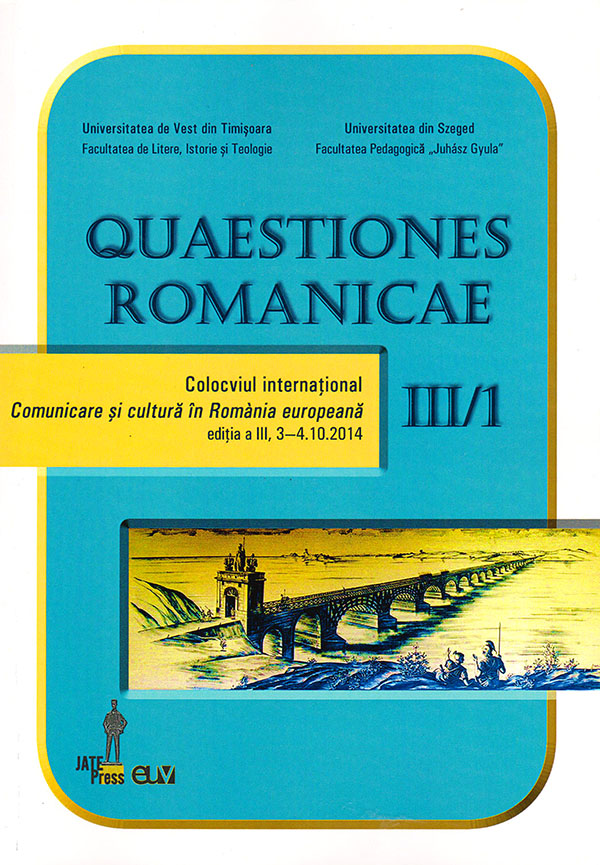Influenţa maghiară în toponimia văilor Bistra şi Sebeş
Abstract: (The Hungarian Influence on the Toponymy of Bistra and Sebeş Valleys) The linguistic consequences of the contact between Romanians and Hungarians are evident on the level of Romanian vocabulary and consequently on the level of toponymy. The influence of the Hungarian language on the vernacular languages spoken in Banat was less strong than the influence on the vernacular languages spoken in Transylvania (for example), because the Hungarian rule in this region did not last so long. The Hungarian borrowings penetrated into Romanian language (either through the direct contact between the two populations, or on the official way), spread easily and gained acceptance from the bottom up, which ensured them a stronger resistance in time. In case of these borrowings there can be talked about two layers: a qualitatively thinner yet strongly naturalized one, which now belongs to the common Romanian language and dated back to the first centuries of linguistic contacts between Romanians and Hungarians, and a second one, thicker but limited to some regions in the North-Western of the country, a layer which is subjected to a continuous shrinking process. The Hungarian influence on the vocabulary of Romanian Banat vernaculars is decreasing on one side because some words related to the old social life organization became out-of-date and disappeared, and on the other side because of the disappearance of the dialectal words as a result of the literary language influence. This is why we consider it extremely important to put attention on toponymy - the real language action archive a nation has. The toponyms of Bistra and Sebeş Valleys (Caraş-Severin County), a vivid expression of life continuity in this region, bring or bring back to spotlight appellatives referring to different aspects of material or spiritual life, anthroponyms but also toponyms of Hungarian origin.
Keywords: toponymy, Hungarian influence, Bistra and Sebeş Valleys.
Rezumat: Consecinţele lingvistice ale contactului dintre români şi maghiari sunt evidente la nivelul lexicului limbii române şi implicit al toponimiei. Influenţa limbii maghiare asupra graiurilor din Banat a fost mult mai slabă decât asupra graiurilor transilvănene (de pildă), întrucât stăpânirea maghiară aici a fost de durată mai scurtă. Împrumuturile din maghiară au pătruns (fie prin contactul direct dintre cele două populaţii, fie pe cale oficială), s-au răspândit uşor şi s-au impus de jos în sus, ceea ce le-a asigurat o rezistenţă mai mare în timp. În cazul acestor împrumuturi se poate vorbi de două straturi: unul, mai subţire din punct de vedere cantitativ, dar puternic încetăţenit, aparţinând limbii române comune şi datând din primele veacuri de contact lingvistic între români şi maghiari, altul, mai gros, dar limitat la unele ţinuturi din nord-vestul ţării şi supus unui proces continuu de reducere. În lexicul graiurilor româneşti din Banat, influenţa maghiară este în regres, pe de o parte prin dispariţia unor termeni perimaţi, legaţi de vechea organizare a vieţii sociale, iar pe de altă parte prin dispariţia cuvintelor dialectale sub impulsul limbii literare. De aceea găsim deosebit de importantă îndreptarea atenţiei asupra toponimiei, adevărată arhivă a faptelor de limbă a unui popor. Toponimele văilor Bistra şi Sebeş, expresie vie a continuităţii vieţii pe aceste meleaguri, aduc sau readuc în lumina reflectorului apelative referitoare la diverse aspecte ale vieţii materiale şi spirituale, antroponime, dar şi toponime de origine maghiară
Cuvinte-cheie: toponimie, influenţa maghiară, valea Bistrei şi a Sebeşului.
